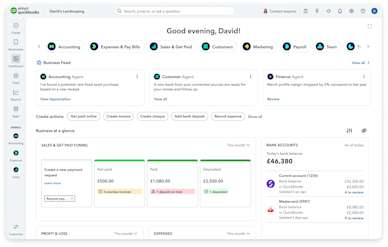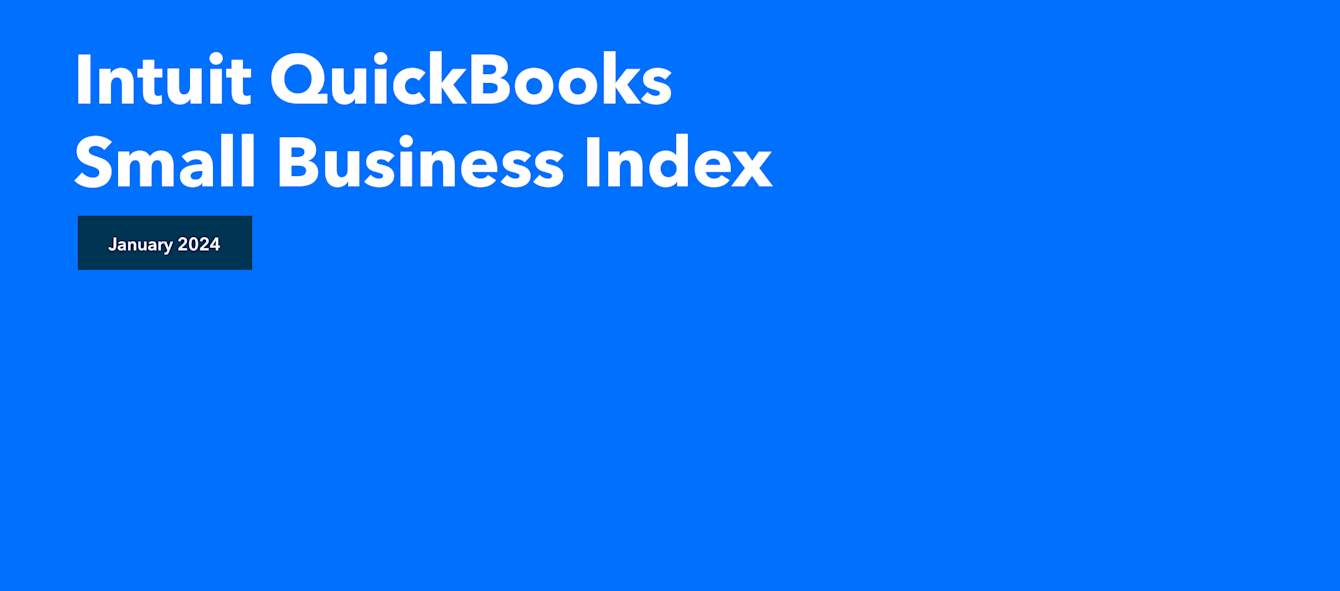
Working in the cloud
Your partner in business
Simple, smart accounting software - no commitment, cancel anytime

GROWING YOUR BUSINESS
Small businesses with one to nine employees currently have 138,100 job vacancies nationwide—a decrease of 3,900 in December compared to November.
The monthly decrease in December was 2.79% below the previous official benchmark of 142,000 small business job vacancies published in the Office for National Statistics’ December 2023 Vacancy Survey.*
Eleven of the 13 sectors covered by the Intuit QuickBooks Small Business Index in the UK posted fewer small business job vacancies in December. Transport and storage (SIC H), and information and communication (SIC J) stand out as the only two sectors to see growth in December, with a monthly increase of 0.28% and 0.12% respectively.
Construction (SIC F), real estate (SIC L), and manufacturing (SIC C) contracted the fastest. These sectors report a monthly decrease of more than 6%.
Small business job vacancies were down in all four UK nations in December. Wales had the fastest monthly rate of decline at 9.65%, falling from 5,000 to 4,500 job vacancies. England contracted the slowest, with a monthly rate of decline of 2.93% and 3,700 fewer vacancies—falling from 126,100 to 122,400.
Get all the details from the interactive Small Business Index dashboard.
Media contact details for QuickBooks in the UK can be found here on the QuickBooks UK website.
The Intuit QuickBooks Small Business Index is also published monthly in the US. Get the latest small business employment insights for the US here.
The Intuit QuickBooks Small Business Index is also published monthly in Canada. Get the latest small business employment insights for Canada here.
The Intuit QuickBooks Small Business Index is a timely new measure of small business employment and hiring in the UK, the US and Canada. The Index launched in March 2023 and is updated monthly. The Index uses purpose-built economic models to normalise anonymised QuickBooks data to reflect the general population of small businesses in each country; it is not a reflection of Intuit’s business. The Index was developed in collaboration with leading economist Professor Ufuk Akcigit and an international team of researchers and academics.
Intuit QuickBooks Small Business Index: Overview
The Intuit QuickBooks Small Business Index creates aggregated data outputs from a sample of anonymised QuickBooks Online Payroll customer records which are calibrated using statistical methods to create modelled results which better reflect the general population of small businesses in each country, as represented by published official statistics. Statistical adjustment ensures the Index truly reflects employment and job vacancy changes rather than trends in the QuickBooks customer base.
Read more or download the full methodology.
Total and monthly changes in employment and job vacancies have been rounded to the nearest hundred. Monthly changes and growth rates are calculated before total employment or job vacancy values are rounded. Rates have been rounded to the nearest hundredth.
The Index’s data insights are seasonally adjusted to limit the effect of seasonal patterns in employment and hiring throughout the year, which lead to regular fluctuations in workforce growth and contraction.
Employment growth(t) = [Employment(t)-Employment(t-1)]/[0.5*Employment(t)+0.5*Employment(t-1)]
The Index produces a monthly prediction of employment growth rates by country, region, and sector. In order to translate these growth rates into the number of jobs/vacancies gained or lost, the growth rates are multiplied by the prior month’s predicted employment levels, except during the months when official statistics are published. During those months, the latest official employment levels that have been reported are used in the calculation instead of the Index’s prior month’s predicted employment levels. As a result, the Index’s predicted total employment levels may at times differ from the predicted growth rates. Official statistics are published at different frequencies depending on the country ranging from monthly to quarterly.
The Index uses data going back to January 2018 in the UK and to January 2015 in the US and Canada. Published at the earliest opportunity every month, the Index shows the number of job vacancies at small businesses (in the UK) or the number of people employed by small businesses (in the US and Canada) in the previous month and how that number has changed since the month before. The Index helps to eliminate almost all of the time lags in official statistics by providing estimated projections of what those statistics will ultimately show when they are published.
The total sample across all three countries is around 424,000 small businesses. The UK sample is almost 25,000 small businesses. The US sample is almost 333,000 small businesses. The Canadian sample is almost 66,000 small businesses. The minimum sample sizes for regions or sectors to be included in the Index are 200 small businesses in the UK, 1,000 small businesses in the US and 800 small businesses in Canada.
In the UK and US, the Index targets the populations of small businesses with one to nine employees. In Canada, the target population is small businesses with one to 19 employees. The differences ensure the Index’s data insights are consistent with official statistics in each country, which are used for benchmarking during the calibration process. Timely data insights for these populations of small businesses are particularly valuable since most datasets fail to cover this portion of the economy well. Please note: Unlike in the US and Canada, the UK Index uses job vacancy data for calibration rather than employment data because official employment statistics are not currently available for small businesses on a monthly basis.
External data sources used alongside the samples of anonymized QuickBooks Online Payroll customer data include:
UK Office for National Statistics job vacancy data
In the UK, data insights are currently available at the country level (England, Scotland, Wales, Northern Ireland) — not regionally within countries
In the UK, data insights are available by UK Standard Industrial Classification of Economic Activities (SIC) sectors (known as “sections”)
Disclaimer
This content is for information purposes only and should not be considered legal, accounting or tax advice, or a substitute for obtaining professional advice specific to your business. Additional information and exceptions may apply. Applicable laws may vary by region, state or locality. No assurance is given that the information is comprehensive in its coverage or that it is suitable in dealing with a customer’s particular situation. Intuit does not have any responsibility for updating or revising any information presented herein. Accordingly, the information provided should not be relied upon as a substitute for independent research. Intuit does not warrant that the material contained herein will continue to be accurate nor that it is completely free of errors when published. Readers should verify statements before relying on them.
We may occasionally provide third-party links as a convenience and for informational purposes only. Intuit does not endorse or approve the views or opinions of any corporation or organisation or individual herein. Intuit accepts no responsibility for the accuracy, or legality, of third-party content.
Subscribe to get our latest insights, promotions, and product releases straight to your inbox.
9.00am - 5.30pm Monday - Thursday
9.00am - 4.30pm Friday